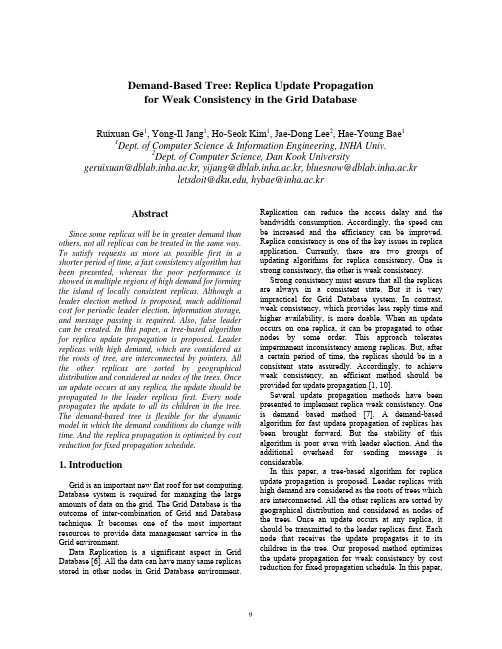GIS相关论文
GIS空间分析论文

《空间分析》课程报告学院:专业:学号:姓名:引言 (3)1. 学校选址研究的意义 (3)2. 位址选择准备 (4)2.1 位址选择 (4)2.2 学校选址的一般要求 (4)2.3 确定权重 (4)2.4 学校选址框架图 (5)3. 利用ArcGIS进行学校选址 (5)3.1 距离制图 (5)3.2 表面分析 (5)3.3 重分类 (5)3.3.1 新值取代原来值 (5)3.3.2 重新组合分类原值 (6)3.3.3 以一种分类体系对原始值进行分类 (6)3.3.4 指定值空值设置 (6)3.4 栅格计算 (6)4. 实验数据 (6)5. 数据处理过程及结果 (6)5.1 添加数据,并设置空间分析环境 (6)5.2 提取学校和娱乐场所直线距离数据集 (8)5.2 从DEM 数据提取坡度数据集 (9)5.3 重分类数据集 (10)5.3.1 重分类坡度数据集 (10)5.3.2 重分类娱乐场直线距离数据集 (11)5.3.3 重分类现有学校直线距离数据集 (12)5.3.4 重分类土地利用数据集 (13)6. 结论 (16)GIS在学校选址中的应用姓名:学号:摘要:栅格数据结构简单、直观,非常利于计算机操作和处理,是GIS常用的空间基础数据格式。
基于栅格数据的空间分析是GIS空间分析的基础,也是ArcGIS空间分析模(SpatialAnalyst)的核心内容。
ArcGIS 空间分析模块(Spatial Analyst)提供了一个范围广阔且功能强大的空间分析和建模工具集,它允许用户从GIS数据中快速获取所需信息,并以多种方式进行分析操作,包括距离制图、密度制图、表面生成、表面分析、统计分析、重分类、栅格计算,等等。
合理的学校空间位置布局,有利于学生的上课与生活。
学校的选址问题需要考虑地理位置、学生娱乐场所配套、与现有学校的距离间隔等因素,从总体上把握这些因素能够确定出适宜性比较好的学校选址区。
关键词:栅格数据;空间分析;学校选址中图分类号:查中图分类号手册文献标志码:The application of GIS in school locationAbstract:Raster data structure is simple, intuitive,and very easy to computer operation and treatment, it is the commonly used in GIS space based on data format. The space analysis based on the grid data is the fundamental of GIS spatial analysis,also is core content to ArcGIS space analysis module (Spatial Analyst). ArcGIS space analysis module (Spatial Analyst) provides a wide range and powerful Spatial analysis and modeling tool set,which allows users get the information quickly from GIS data, and to provides various analysis operations, including distance drawing, density drawing, surface formation, surface analysis, statisticalanalysis,reclassification, and raster calcunation, and so on. Reasonable school space position is good for the students of study and life. School issues consider the site selection of the geographical position, places of entertainment facilities, and existing school distance interval in general and other factors. Grasping these factors can determine the suitability better school location area.Key words: Raster data;Spatial Analyst;school location引言社会的发展带动了各行各业的发展,学校是培养人才的地方,ArcGIS具有功能强大、应用领域非常广泛,在社会公共安全与应急服务、国土资源管理、遥感、智能交通系统建设、水利、电力、石油、国防、公共医疗卫生、电信等方面和领域都有深入的应用。
GIS在风景园林规划中的应用(课程论文)

GIS在风景园林规划中的应用(课程论文)第一篇:GIS在风景园林规划中的应用(课程论文)GIS在风景园林规划中的应用摘要:地理信息系统(GIS)是一个收集、储存、分析和传播地球上关于某一地区信息的系统。
一个完整的GIS必须具备输入、存贮、操作和分析、表达输出四大功能。
GIS以其强大的地理信息空间分析功能,在环境及景观规划项目中发挥着越来越重要的作用,它的发展与某些领域尤其是环境规划设计领域的实践是相互促进的。
作为一个强大、灵活的决策系统,它不仅见于大范围的城市及地区的自然资源保护及管理,而且很多城市的风景园林规划等行业也正在接受这一技术。
但它也存在着一些不足,目前GIS的分析与展示诸如噪声、能量平衡、城市气候等环境因子方面的能力,还是有限的。
关键词:GIS;环境;景观;规划The Application for GIS in the Landscape PlanningAbstract:Geographic Information System is a system that can do data capture, storage, analysis, and display for certain area on the earth. So a complete GIS must possess four functions mentioned above essentially. GIS is playing more and more important role in the projects of environment and landscape planning because of its powerful function in spacial analysis of Geo-Information. As a powerful and flexible technology for decision-making, it is not only employed by the resources protection and management for a wide range of urban and natural resources, but also adopted by many fields that are related to urban landscape design. But certain projects still can identified some shortcomings of GIS, it also lacks capabilities for analyzing and displaying qualitative aspects of the environment such as noise, energy balance, urban climate, etc.Key words: GIS;application;landscape;planningGIS即地理信息系统(Geographic Information System),经过了40年的发展,到今天已经逐渐成为一门相当成熟的技术,并且得到了极广泛的应用。
GIS及其在土地管理中应用论文

浅谈GIS及其在土地管理中的应用摘要:土地管理是一项复杂而系统的工程,gis具有强大的信息管理能力。
将gis应用于土地管理将极大地提高社会效益和经济效益。
笔者对gis进行了介绍,并根据工作实际对gis的应用、存在的问题及发展的趋势进行了探讨。
关键词:数字地球;gis;土地管理;应用;存在的问题;发展的趋势1、地理信息系统(gis)联合国有关文件曾明确指出“地理空间信息是实现可持续发展的利器”,而且“进入信息化社会后,人们每天接触到的信息中的80%以上与地理空间信息有关”。
1998年江泽民总书记在接见两院院士代表的讲话中指出:“当今世界,以信息技术为主要标志的科技进步日新月异,高科技成果向现实生产力的转化越来越快,初见端倪的知识经济预示人类的经济社会生活将发生新的巨大变化”。
顺应经济全球化,全球信息化的发展趋势,为使国土资源工作更好地适应我国可持续发展的需要,国土资源部将”加强信息系统建设,实现信息服务社会化”列为五大目标任务之一,并在新一轮国土资源大调查计划中设立“数字国土”工程,旨在通过信息基础设施建设,加速实现国土资源调查评价、规划、管理、保护和合理利用的现代化,为全社会提供方便快捷的国土资源信息服务,充分发挥国土资源在国家社会经济发展中的基础性、公益性和战略性作用。
数字地球在这方面可以发挥更大的作用。
什么是“数字地球”呢?所谓“数字地球”,可以理解为对真实地球及其相关现象统一的数字化重现和认识。
其核心思想是用数字化的手段来处理整个地球的自然和社会活动等方面的问题,最大限度地利用资源,并使普通百姓能够通过一定方式方便地获得他们所想了解的有关地球的信息,其特点是嵌入海量地理数据,实现多分辨率、三维对地球的描述,即“虚拟地球”。
数字地球的核心是地球空间信息科学,地球空间信息科学的技术体系中最基础和基本的技术核心是3s技术及其集成。
所谓3s是全球定位系统(gps)、地理信息系统(gis)和遥感(rs)的统称。
数字地图制图与GIS论文

数字地图制图与GIS摘要:随着现代科学技术的发展,城市地理信息系统(gis)将大大推动了地图制图的飞速发展。
本文着重从数字地图制图与gis的关系、发展趋势、具体应用等几个方面进行了介绍,基于实际工作的体会,认为gis的引入给地图学的发展带来了巨大的促进作用。
关键词:数字地图制图 gis 发展趋势0 引言地理信息系统(gis)是一种特定的空间信息系统,它在计算机软件、硬件的支持下,对整个空间中的地理分布数据进行采集、储存、管理、运算、分析等的技术系统。
它管理的对象是多种地理空间实体数据及其关系,包括空间定位数据、图形数据、遥感图像数据等,用于分析和处理在一定地理区域内分布的各种现象和过程。
计算机技术的发展及其在地图学中的应用对地图制图产生了深刻影响。
在应用早期,计算机被作为模仿传统手工生产地图产品的工具。
当计算机引入到地图学中后,便彻底改变了人们对地图制图的理解以及实践的方式。
同时,由于任何拥有制图软件包和合适硬件的人都能生产地图或类似地图的产品,因而计算机的应用也影响了专业地图工作者对制图原则和地图学理论的重新思考,促使地图学的概念发生了全新的改变,结束了只用纸、薄膜作为地图信息承载的主体。
中国地理信息系统自20世纪80年代诞生以来,经过20多年的发展壮大,已由最初的应用技术发展成为一门具有自身理论体系的空间信息系统,并在国家信息化、国家安全、经济建设、科学研究等方面发挥越来越重要的作用。
测绘行业也随着gis的发展迎来了数字化时代,数字地图是gis的基础资料,gis软件平台中数据的采集和输入过程,就是测绘数字化地形图的过程。
因此,测绘行业是gis的前沿阵地,是gis软件最早的实践者和应用者。
1 从计算机地图制图到gis计算机地图制图是gis采集、储存、处理空间数据的有力工具和手段。
严格地讲,计算机地图制图是以传统的地图制为原理为基础,利用电子计算机及其连结的输入、输出装置作为主要工具,采用数据库技术和图形数字处理方法,实现地图信息的获取、变换、传输、识别、存储、处理、显示和绘图输出。
GIS毕业论文地理信息系统论文题目

GIS毕业论文地理信息系统论文题目地理信息系统(GIS)作为重要的空间信息系统,将地理学与地图学以及遥感和计算机科学融为一体,在工程建设、环境监测、交通导航等方方面面得到普及应用,成为了重要的地理信息分析处理工具,下面学术堂总结了近年来100个地理信息系统论文题目(GIS毕业论文题目)供大家参考!1、GIS技术对工程测量的影响分析2、GIS技术在城市景观设计中的应用3、GIS技术在国内环境风险评价中的应用研究4、GIS技术在矿业权价款评估中的应用研究5、GIS空间分析在学区划分中的应用6、GIS在城市智能公交系统中的应用7、GIS在农村零售商店选址中的应用8、GIS在绥化城区烟草物流配送路线优化中的应用9、GIS在土壤重金属污染治理中的应用实例10、GIS在校园导航中的应用11、GIS支持下的城市小区的居住适宜性分析研究12、GIS支持下的地质灾害防治信息平台建设13、GIS专题数据采集与建库项目质检研究14、OSM在极地GIS中的应用15、测绘工程地理信息系统GIS应用16、大数据背景下基于GIS的景观评价方法探究17、大数据在地理信息系统中的应用分析18、地理信息系统对羌族文化旅游的价值19、地理信息系统及其在海洋科学中的应用20、地理信息系统技术在环境影响评价中的应用21、地理信息系统在城市排水管网中的应用22、地理信息系统在地质矿产勘查方面的应用23、地理信息系统在地质灾害中的应用研究24、地理信息系统在环境应急监测中的应用研究25、地理信息系统在森林防火中的应用26、地理信息系统在智慧城市中的运用27、高速铁路GIS平台研究与实现28、基于AE的二三维一体化GIS技术研究29、基于GIS的城市道路黑点分析与决策支持研究30、基于GIS的城市道路数字化照明系统的设计31、基于GIS的城市空间扩展预测32、基于GIS的城市绿化管理系统的研究--以江门市为例33、基于GIS的城市事故应急决策支持系统研究34、基于GIS的城市应急避难场所布局研究35、基于GIS的城市院落形态分布特点研究分析36、基于GIS的地铁站步行可达性研究37、基于GIS的洞庭湖区水土流失变化监测38、基于GIS的犯罪模式分析研究39、基于GIS的防汛抢险信息系统开发与应用40、基于GIS的福建省湖雷地区钼矿成矿预测41、基于GIS的广西陆川县地质灾害危险性评价42、基于GIS的洪灾损失地理评估方法及应用43、基于GIS的江苏省公共文化服务供给新模式研究44、基于GIS的江苏太湖流域景观格局优化45、基于GIS的矿山地质灾害现状评估46、基于GIS的路径规划算法研究与实现47、基于GIS的旅居养老目的地适宜性评价48、基于GIS的旅游住宿餐饮信息系统的研究与实现49、基于GIS的泥石流灾害三维遥感分析50、基于GIS的农村宅基地建库研究与实现51、基于GIS的农户生计安全评价与分析52、基于GIS的山地城市建筑高度控制方法及其应用53、基于GIS的山地流域景观格局变化及脆弱性评价54、基于GIS的山西省暴雪灾害风险区划研究55、基于GIS的陕西省雾霾分析56、基于GIS的射洪县退耕还林决策分析57、基于GIS的石家庄市土地利用变化分析及预测58、基于GIS的天河区应急式项目选址规划研究59、基于GIS的土地利用监管信息系统建设研究--以洋县为例60、基于GIS的土壤侵蚀与土地利用关系研究61、基于GIS的乌海矿区土地退化因素分析62、基于GIS的园地适宜性评价研究--以湖南零陵区为例63、基于GIS的最优路径选择的设计与实现64、基于GIS技术的高校图书馆座位管理系统65、基于GIS技术的森林公园道路选线设计与规划66、基于GIS技术的医院空间布局设计研究67、基于GIS空间分析的居民点分布优化--以茂县为例68、基于GIS项目管理系统设计与实现69、基于GIS引水线路优化方法研究70、基于GIS与约束条件下的最优路径规划研究71、基于GIS在水文水资源领域中的应用分析72、基于RS与GIS的土地利用类型研究与分析73、基于地理信息系统的林业调查技术的研究74、基于地理信息系统的配电网优化设计75、基于三维GIS的楼宇租赁管理研究76、基于三维GIS的石油管线管理信息系统77、基于遥感数据挖掘的智能地理信息系统设计78、基于移动GIS的地下管线应用的设计与实现79、基于移动GIS的水环境监察系统设计与实现80、基于云计算的GIS软件持续集成应用研究81、警用地理信息系统的设计与建设82、美丽乡村地理信息系统的设计与实现83、南京市水利地理信息系统的设计与实现84、鄱阳湖水利工程地理信息系统研究85、浅论地理信息系统在航道管理中的应用86、浅谈线变户GIS数据采集方法87、浅析GIS的地下管线查询与管理系统88、浅析地理信息系统的发展趋势89、浅析云计算在GIS中的应用90、三维GIS符号化表达系统的设计与实现91、三维地理信息系统应用技术综述92、石化企业设备管理平台GIS系统的应用研究93、水利水电网络地理信息系统模型研究94、谈GIS技术与BIM理念的结合95、铁路三维地理信息系统构建技术研究96、铁路信号地理信息系统建设97、移动规划GIS服务平台建设98、云GIS平台构建的关键技术研究99、云GIS下智慧城市地理空间信息共享平台构建100、中国风景园林规划设计领域GIS的应用研究以上是GIS毕业论文题目,希望对从事GIS领域学习研究的同学和老师有所帮助。
gis地理信息系统论文

gis地理信息系统论文:GIS它是一种特定的十分重要的空间信息系统。
它是在计算机硬、软件系统支持下,对整个或部分地球表层空间中的有关地理分布数据进行采集、储存、管理、运算、分析、显示和描述的技术系统。
以下是小编精心准备的gis地理信息系统论文,大家可以参考以下内容哦![摘要]随着我国经济的发展,我国地理信息系统随之得到广泛的应用。
本文通过对我国地理信息系统的概念以及其发展等方面进行分析,期望能更好的推动其在各个领域的广泛应用。
[关键词]地理信息 GIS 发展应用0引言GIS的发展一方面使得计算机知识得到了推广和应用,另一方面也提高了我国信息技术。
对基于计算机技术的GIS 技术的发展趋势进行探讨,能够有效指导GIS 研究工作的开展。
1地理信息系统概述1.1地理信息系统的基本概念地理信息系统(GIS肠eogarphiealIL-oflrmationSystem)是一种决策支持系统,具有信息系统的各种特点,一方面,它是一门介于地球科学与信息科学之间的交叉类学科,另一方面它是在计算机硬件和软件系统的支持下对整个或部分地球表层(包括大气层)空间中的地理分布数据进行采集、储存、管理、运算、模拟、分析、显示和描述的技术系统。
综合而言它是为区域和工程规划、设计、管理决策服务的信息加工与管理技术的学科池是一种综合性强、适用性广的工具。
1.2地理信息系统的构成地理信息系统(GSI)是由计算机硬件、软件和不同的方法组成的系统该系统设计支持空间数据的采集、管理、处理、分析、建模和显示,以便解决复杂的规划和管理问题。
1.3地理信息系统(GSI)的特征地理信息系统具有以下三个方面的特征:1.具备采集、管理、分析和输出多种地理空间信息的能力具有很强的空间性和动态性;2.以地理研究和地理决策为目的,以地理模型方法为手段,具有空间分析、多要素综合分析和动态预测的能力,并能产生高层次的地理信息;3.由计算机系统支持进行空间地理数据管理。
开发GIS项目程序设计论文

摘要近年来,地理信息系统(GIS)是储存和处理与地理空间分布有关信息的集合。
在各行各业得到越来越广泛的应用,GIS以其混合数据结构和独特的地理空间分析功能独树一帜在税务系统中也开始广泛的应用,不仅仅表现为提高管理的效率,而且增加了管理的功能。
通过对组件式GIS技术的分析,还比较了WebGIS 和VC++等技术,我们决定选用VC++基于进行GIS的开发企业分布地理信息系统。
本系统借助计算机完成企业的分布的电子地图,首先注册才能获取应用的权限,实现了鹰眼功能,一个地区地图的放大缩小漫游,箭头编号标柱点选框选圆选选择符号图层控制按企业编号,企业名字查找及企业的添加,删除等功能,当然后几项功能只有管理员才可以有使用权限。
当选择选择方式进行选择之后,可以显示出被选中企业的名字,然后你可以点击企业的名字在地图上就会把这个企业的位置显放大显示在中心位置,况且不断的闪烁,还可以显示企业的详细信息关键词:VC++;地理信息系统;电子地图ABSTRACTRecently, geographical information system (GIS) is the combination of savior and operation and information regarding distribution of geographical space. Applied to more and more wide fields of industry, GIS has developed a school of one´s own with its mixed structure of data and the unique annalistic of geographical space, making it start to be employed into tax system. All the above can be approved by improving efficiency of management as well as increasing capability of management. Through annalistic GIS technique of subassembly and comparison to WebGIS and VC++, we decide to adopt VC++ based on geographical information system of enterprise distribution that was projected for second times.By dint of computer, the system complete the electrical map of enterprise distribution which be utilized only after the first registration. It realizes such features as eye of hawk zoom out and zoom in of a city’s map, roam, arrowhead, marks of serial number, dot option, column option, round option, optical symbol, drawing control, giving number according enterprises, seeking a name of enterprise, adding to and delete enterprise, etc. certainly the latter several features only be eligible to the administrators. When choose the optical type and select from them, the selected name of enterprise would be visible, and then click the name of enterprise. As result of this, the name of enterprise will be amplifier and show in the center of a map, flickering continuously, show the detailed information of a company.Owing to the limit of time and condition, I am afraid that the unfinished features that I should have planned to complete in a form of C/S need to realize in the later extending.Key words:VC++;GIS;electrical map目录1 实现图形系统的文档和视图 (1)1.1 组织矢量图形系统的图形元素类 (1)1.2 组织矢量图形系的文档 (3)1.2.1 组织面向对象的文档管理机制 (3)1.2.2 利用MFC摸板创建管理图形元素对象指针的对象 (3)1.2.3 实现矢量图形系统的文档 (3)1.2.4 实现文档的管理功能 (3)1.3 实现矢量图形系统的视图 (5)1.3.1 建立坐标系 (5)1.3.2 实现各类图形元素的绘制功能 (6)1.3.3 实现视图 (6)1.4 各类图形元素几何属性的计算 (7)2 鼠标交互绘图 (7)2.1 用鼠标绘图要解决的主要问题 (7)2.1.1 捕获鼠标操作消息 (7)2.1.2 捕捉所有的鼠标输入 (7)2.1.3 在屏幕上拖动图形 (7)2.1.4 保存图形数据到文档 (7)2.1.5 将图形以实际的形态重画 (7)2.2 交互绘制各类图形元素 (8)3矢量图形系统的操作功能 (9)3.1 增加图形操作菜单 (9)3.2 图形重画 (9)3.3 图形放大和摆动 (11)3.4 重画上屏和重画首屏 (11)3.5 显示全图 (13)3.5.1 各类图形元素的边界矩形计算 (13)3.5.2 实现显示全图功能 (13)3.6 提高矢量图形系统重画速度的基本方法 (14)3.6.1 提高图形重画速度的方法 (14)3.6.2 提高图形元素的绘制速度 (16)4 图形的选中、移动、旋转、删除 (16)4.1 鼠标点选图形元素 (16)4.2 图形移动 (20)4.3 图形旋转 (21)4.3.1 点与点的旋转操作 (21)4.3.2 各类图形元素的旋转操作 (22)4.3.3 实现旋转操作功能 (22)4.4 图形元素的删除 (22)5 数据库应用程序开发技术 (24)5.1 创建基于ODBC的数据库应用程序 (24)5.2 CRecordSet类功能分析 (24)5.3 CRecordView视图类分析 (26)6 实现数据库浏览功能 (27)6.1 创建一个数据库浏览视图 (27)6.2 创建一个CRecordSet派生类对象 (28)6.3 实现数据库浏览试图 (28)7 实现数据库编辑功能 (28)7.1 建立并初始化存储记录指针的变量 (28)7.2 建立数据库编辑功能操作菜单 (29)7.3 建立编辑数据记录的对话框类 (29)7.4 增加和修改数据记录 (29)7.5 删除记录 (29)8 通用数据库过滤功能 (30)8.1 过滤操作的实现方式 (30)8.2 创建组织过滤条件的对话框类 (30)8.3 组织过滤条件编辑器的各种功能 (30)8.4 在数据库浏览视图中实现过滤功能 (31)8.5 增加过滤条件编辑器的功能 (31)参考文献 (33)1 实现图形系统的文档和视图1.1 组织矢量图形系统的图形元素类城市的信息化为城市GIS发展带来了机遇。
地形测量技术设计论文

地形测量技术设计论文引言地形测量是地理信息系统(GIS)中的重要组成部分,它通过收集和分析地表特征的数据来提供地貌地貌和地形信息。
在建设工程、地理勘测、农业规划等领域中,地形测量技术被广泛应用。
本论文将讨论地形测量技术的设计原理和方法,以及其在不同领域中的应用。
1. 设计原理地形测量技术的设计原理基于测量和分析地球表面特征的方法。
下面将介绍几种常用的地形测量技术设计原理。
1.1 大地测量法大地测量法是地形测量中最常用的技术之一。
它利用全球定位系统(GPS)和电子测距仪等设备测量地点之间的水平和垂直距离,以及地球曲率和重力等参数,来确定地表的几何形状和地貌特征。
大地测量法可以精确测量地球表面的高程、坡度和弯曲等参数。
1.2 遥感技术遥感技术是通过卫星或飞机上的传感器获取地表特征的图像和数据。
遥感技术可以提供高分辨率的地表图像,在地形测量中有广泛的应用。
遥感技术可以通过分析数字图像、激光数据和红外线图像等数据源,测量地表高程、地形特征和地貌变化。
1.3 激光测距技术激光测距技术是一种高精度的地形测量方法。
它利用激光束测量地球表面和地下物体之间的距离,并根据测量结果创建数字地形模型(DTM)。
激光测距技术可以精确测量地表的高程、坡度和形状,广泛应用于地质勘探、城市规划和环境监测等领域。
2. 设计方法地形测量技术的设计方法是指在实际应用中采用的数据采集和分析方法。
下面将介绍几种常用的地形测量技术设计方法。
2.1 数据采集在地形测量技术的设计过程中,首先需要进行数据采集。
数据采集可以通过现场测量、遥感技术和激光测距技术等方法来进行。
在数据采集过程中,需要选择合适的测量设备和技术,以获得准确和可靠的地形数据。
2.2 数据处理数据处理是地形测量技术设计中的一个重要环节。
它包括数据的预处理、质量控制和分析等步骤。
数据的预处理包括数据去噪、纠偏和校正等操作,以提高数据的准确性和可用性。
数据的质量控制包括检查和修正数据中的错误和不一致性。
(地图学与地理信息系统专业优秀论文)基于GIS技术的水环境污染模拟研究

图2—1GIS技术发展里程为解决集成式GIS与模块化GIS的缺点,GIS和计算机领域的专家们提出了核心式GIS(CoreOlS)的概念。
核心式GIS被设计为操作系统的基本扩展。
Windows系列操作系统上的核心式GIS提供了一系列动态连接库∞LL),开发GIS应用系统时可以采用现有的高级编程语言,通过应用程序接t](API)访问内核所提供的GIS功能。
除了一些基本的动态连接库以外,实现各种功能的动态连接库可以被拆卸和重组,它提供了动态连接库一级的更底层的组件化方式,给用户提供更大的灵活性。
对数据库管理要求较多的用户甚至可以选择MIS开发工具来构造GIS应用,为GIS与MIS的无缝集成提供了全新的解决思路。
但是,由于核心式GIS提供的组件过于底层,给应用开发者带来一定难度,也不适应可视化程序设计的潮流。
随着计算机软件技术的发展,GIS组件化发展到了一个全新的阶段,出现了组件式GIS(ComponentsGIS,缩写为ComGIS)。
组件式GIS基于标准的组件式平台,各个组件之间不仅可以进行自由、灵活的重组,而且具有可视化的界面和使用方便的标准接口。
组件式平台主要有Microsoft的COM(ComponentObjectModel,组件对象模塑.A)/DCOM(DistdbutedComponentObjectModel,分布式组件对象模型)和OMG的CORBA(CommonObjectRequestBrokerArchitecture,公共对象请求代理体系结构),目前Microsoft的COM/DCOM占市场领导地位。
基于COM/DCOM,Microsoft推出了ActiveX技术,ActiveX控件是当今可视化程序设计中应用最为广泛的标准组件。
新一代的组件式GIS也大都是ActiveX控件或者其前身OLE控件。
组件式GIs代表着当今GIS发展的潮第10页信息工程大学硕士学位论文第五章应用案例研究本文选取黄河段硫化物污染、丹江口多湖库BOD污染、郑州市地下水污染分别作为河流、湖泊(水库)和地下水污染的案例进行水质污染模拟研究。
关于GIS的论文

关于GIS的论文GIS论文一、MAPGIS概述物质世界中的任何地物都被牢牢地打上了时空的烙印。
人们的生产和生活中80%以上的信息和地理空间位置有关。
GIS---Geographic Information System,地理信息系统是一种基于计算机的工具它可以对在地球上存在的东西和发生的事件进行成图和分析。
地理信息系统(Geographic Information System, 简称GIS)作为获取、处理、管理和分析地理空间数据的重要工具、技术和学科近年来得到了广泛关注和迅猛发展。
GIS的发展虽然较晚经历了四个阶段即起步(1970-1980)、准备(1980-1985)、发展(1985-1995)、产业化(1996以后)阶段。
GIS已在许多部门和领域得到应用并引起了政府部门的高度重视。
从应用方面看地理信息系统已在资源开发、环境保护、城市规划建设、土地管理、农作物调查与结产、交通、能源、通讯、地图测绘、林业、房地产开发、自然灾害的监测与评估、金融、保险、石油与天然气、军事、犯罪分析、运输与导航、110报警系统公共汽车调度等方面得到了具体应用。
国内外已有城市测绘地理信息系统或测绘数据库正在运行或建设中。
一批地理信息系统软件已研制开发成功(如GeoSTAR,CityStar,MapGIS 等),一批高等院校已设立了一些与GIS有关的专业或学科一批专门从事GIS产业活动的高新技术产业相继成立。
些外还成立了“中国GIS协会“和“中国GPS技术应用协会“等。
MAPGIS的主要用途有直观、便捷的集成各种属性的数据由于地物的空间位置具有客观性而地物本身又具有纷繁复杂的特性除了具有自然特性以外还具有社会经济特性。
描述这些特性的属性数据非常丰富但都可以通过具有同一坐标参考系统的空间位置进行统一组织。
MAPGIS为各种数据的集成提供了统一的框架在此基础上可以直观表达地物及其空间关系。
在煤矿开发方面MAPGIS有很大的重用处理起来也是很方便对采集来的数据进行分析处理在地形地质图上直观的表示各种地物地理位置情况地形的高低整个煤矿开发区的位置坐标等等精确的表示在图上。
论文格式——精选推荐

论⽂格式论⽂格式模板范⽂(精选6篇) 现如今,⼤家总免不了要接触或使⽤论⽂吧,论⽂的类型很多,包括学年论⽂、毕业论⽂、学位论⽂、科技论⽂、成果论⽂等。
写起论⽂来就毫⽆头绪?下⾯是⼩编收集整理的论⽂格式模板范⽂(精选6篇),希望能够帮助到⼤家。
论⽂格式篇1 摘要:伴随经济社会的飞速发展,⾼速国道⼲线与城市内部道路均存在基础设施建设更新速度快、交通承载压⼒⼤、信息化程度低等特点,难以满⾜现代道路交通体系的数字化要求,迫切要求构建便捷、⾼效、实时的交通地理信息系统。
本⽂以ArcGISEngine开发环境为基础,对道路交通信息系统与ArcEngine组件式平台拟进⾏概要阐述,并按照软件设计的相关原则,对道路交通地理信息系统进⾏了总体设计与功能模块设计。
关键词:ArcGIS;Engine;道路交通地理信息系统;组件式开发 当前国内经济迅速增长,城市化规模不断增⼤,以机动车保有量为代表的道路交通压⼒也与⽇俱增,国内北京、上海、天津等⼤型城市纷纷通过限号形式来减缓道路载荷。
现代信息技术为整合道路交通资源、实现交通数据⾃动化管控提供了数据⽀撑,有利于构建时空⼀体的道路交通地理信息系统。
1.道路交通地理信息系统 ArcGISEngine作为GIS嵌⼊式⼆次开发平台,可摆脱ArcGIS提供组件式多类型开发应⽤程序接⼝API,同时可与MicrosoftVisualStu-dio系统编程集成开发环境相融合,基于进⾏多类编程语⾔下的模块式开发。
以GIS地理信息技术为基础,利⽤ArcGISEn-gine平台将交通路⽹与道路设施等空间信息、车载流量与基础设施等属性数据同航摄影像、多媒体监控数据等有效衔接,实现对空间和属性数据相关的采集、编辑与分析,采⽤GIS最短路径、道路畅通度算法等优化选择合理的交通线路,完成公交布线与站点布设等⼯作,同时融合多媒体监控⼿段,实时显⽰热点路况信息,科学指挥道路交通。
2.系统功能需求分析 从应⽤层⾯分析,道路交通地理信息系统的受众群体分为交通管理⽅与车辆应⽤客户⽅,其中本⽂所探讨的基于ArcGISEngine的应⽤系统主要为交通管理⽅的C/S客户端,具体车辆客户端则可采⽤基于Android、ios或WindowsMobile平台的APP软件;从系统设计的原则分析,应坚持安全性、共享性、可拓展性与可维护性的原则,提升道路交通地理信息系统的综合性发展。
地理信息技术专业优秀毕业论文探索前沿技术的典范研究成果

地理信息技术专业优秀毕业论文探索前沿技术的典范研究成果地理信息技术(Geographic Information Technology)是一门涵盖地理学、计算机科学和信息技术的综合性学科领域。
作为地理信息技术专业的学生,我们致力于研究和开发各类地理信息技术应用,在不断探索前沿技术的过程中,取得了一系列的研究成果。
本文将为您介绍地理信息技术专业优秀毕业论文所取得的重要研究成果。
一、地理数据采集与处理技术地理数据采集与处理技术是地理信息技术的基础,对于精确获取地理数据、保证数据的质量和完整性至关重要。
在论文研究中,我们利用遥感技术、全球定位系统(GPS)等现代科技手段,实现了高精度的地理数据采集。
同时,我们还研究了数据预处理、图像处理和模型构建等相关技术,提高了地理数据的处理效率和准确性。
二、地理信息系统(GIS)应用研究地理信息系统(GIS)是地理信息技术最具代表性的应用之一,它将地理数据和空间分析技术结合,为地理信息的管理、分析和可视化提供了有效的工具。
在我们的研究中,我们基于GIS平台,开发了各种应用系统,如城市交通管理系统、环境资源管理系统等。
通过这些系统的应用,我们能够快速获取和分析地理信息,提供科学决策的支持。
三、地理数据可视化与应用地理数据可视化是将抽象的地理数据转化为直观的可视化表达形式,帮助用户更好地理解和分析地理信息。
在论文研究中,我们使用了各种可视化技术,如地理信息系统的三维可视化、虚拟现实技术等,实现了地理数据的直观展示和沉浸式交互。
同时,我们将这些可视化技术应用于实际场景中,如城市规划、灾害管理等领域,提高了决策效率和信息传达的效果。
四、地理信息技术在智慧城市建设中的应用智慧城市建设是当前城市发展的重要方向之一,地理信息技术在智慧城市建设中发挥着重要作用。
在我们的研究中,我们使用地理信息技术构建了智慧城市相关的数据平台和应用系统。
通过对城市规划、交通管理、环境保护等方面的应用,我们提出了一套可行的智慧城市建设方案,并取得了显著的效果。
GIS相关论文

相关论文1 GIS多源数据集成模式评述地理信息系统的迅速发展和广泛应用导致了空间数据多源性的产生,为数据综合利用和数据共享带来不便。
本文探讨空间数据多源性的产生和表现,指出多数据格式是多源空间数据集成的瓶颈;分析和评价了多源空间数据集成的三种模式,并展望了多源数据集成的发展方向。
2 WebGIS--基于Internet的地理信息系统WebGIS是Internet技术应用于GIS开发的产物。
GIS通过WWW功能得以扩展,真正成为一种大众使用的工具。
从WWW的任意一个节点,Internet用户可以浏览WebGIS站点中的空间数据、制作专题图,以及进行各种空间检索和空间分析,从而使GIS进入千家万户。
3 城市规划与测绘中的地理信息系统综述了地理信息系统(GIS)的产生、发展、范围和组构,着重探索了GIS与测绘的关系及其在城市规划中的应用和发展方向。
4 地理信息系统集成平台框架结构研究提出了基于客户/服务器结构的地理信息系统集成平台总体结构,探讨了基于元数据的地理信息系统数据集成平台以建立物理上分布而逻辑上集中的分布式地理信息系统数据库,提出了应用符合3NF范式的关系数据库进行模型管理的模式,在此基础上探讨了地理信息系统可视化建模工具。
5 地理信息系统技术开发、应用与产品化IS技术已经进入一个新的发展时期,从技术上和应用上,都已经达到了一个新的阶段,它的社会作用和影响,以及所涉及的法律规章,不断扩大。
正确认识GIS的作用和掌握这一技术的发展动向,是我们制定技术和产业政策,以及组织技术开发和产品化的重要前提。
6 地理信息系统在国内外应用现状从GIS基本功能、构成特点出发归纳、总结GIS应用的几个方面,并详细举例说明GIS在国内外的应用现状。
7 对地球信息科学的思考作为地球科学一个重要分支的地球信息科学,在近10多年来已得到人们的广泛关注与高度重视。
本文以信息科学为基础分析信息流的意义及其与物质流和能量流的关系,阐述地球信息科学在地球科学中的地位及其内涵,并从地球信息机理、地球信息技术以及地球信息科学的应用三方面论述地球信息科学研究的主要内容。
GIS英文论文

Demand-Based Tree: Replica Update Propagationfor Weak Consistency in the Grid DatabaseRuixuan Ge1, Yong-Il Jang1, Ho-Seok Kim1, Jae-Dong Lee2, Hae-Young Bae1 1Dept. of Computer Science & Information Engineering, INHA Univ.2Dept. of Computer Science, Dan Kook Universitygeruixuan@dblab.inha.ac.kr, yijang@dblab.inha.ac.kr, bluesnow@dblab.inha.ac.krletsdoit@, hybae@inha.ac.krAbstractSince some replicas will be in greater demand than others, not all replicas can be treated in the same way. To satisfy requests as more as possible first in a shorter period of time, a fast consistency algorithm has been presented, whereas the poor performance is showed in multiple regions of high demand for forming the island of locally consistent replicas. Although a leader election method is proposed, much additional cost for periodic leader election, information storage, and message passing is required. Also, false leader can be created. In this paper, a tree-based algorithm for replica update propagation is proposed. Leader replicas with high demand, which are considered as the roots of tree, are interconnected by pointers. All the other replicas are sorted by geographical distribution and considered as nodes of the trees. Once an update occurs at any replica, the update should be propagated to the leader replicas first. Every node propagates the update to all its children in the tree. The demand-based tree is flexible for the dynamic model in which the demand conditions do change with time. And the replica propagation is optimized by cost reduction for fixed propagation schedule.1. IntroductionGrid is an important new flat roof for net computing. Database system is required for managing the large amounts of data on the grid. The Grid Database is the outcome of inter-combination of Grid and Database technique. It becomes one of the most important resources to provide data management service in the Grid environment.Data Replication is a significant aspect in Grid Database [6]. All the data can have many same replicas stored in other nodes in Grid Database environment. Replication can reduce the access delay and the bandwidth consumption. Accordingly, the speed can be increased and the efficiency can be improved. Replica consistency is one of the key issues in replica application. Currently, there are two groups of updating algorithms for replica consistency. One is strong consistency, the other is weak consistency.Strong consistency must ensure that all the replicas are always in a consistent state. But it is very impractical for Grid Database system. In contrast, weak consistency, which provides less reply time and higher availability, is more doable. When an update occurs on one replica, it can be propagated to other nodes by some order. This approach tolerates impermanent inconsistency among replicas. But, after a certain period of time, the replicas should be in a consistent state assuredly. Accordingly, to achieve weak consistency, an efficient method should be provided for update propagation [1, 10].Several update propagation methods have been presented to implement replica weak consistency. One is demand based method [7]. A demand-based algorithm for fast update propagation of replicas has been brought forward. But the stability of this algorithm is poor even with leader election. And the additional overhead for sending message is considerable.In this paper, a tree-based algorithm for replica update propagation is proposed. Leader replicas with high demand are considered as the roots of trees which are interconnected. All the other replicas are sorted by geographical distribution and considered as nodes of the trees. Once an update occurs at any replica, it should be transmitted to the leader replicas first. Each node that receives the update propagates it to its children in the tree. Our proposed method optimizes the update propagation for weak consistency by cost reduction for fixed propagation schedule. In this paper,it can be seen that our algorithm performs well not only in static model but also in dynamic model by performance evaluation.The rest of this paper is organized as follows. Section 2 gives an overview of previous work on replica update propagation. Section 3 presents our proposed demand-based trees model and algorithms. In section 4, we evaluate our method and describe the results. And the last section is the brief conclusions of this paper.2. Related WorkThis chapter generalizes several existing researches about replica consistency and stresses describing the fast consistency algorithm.2.1. Replica Consistency Service in Grid EnvironmentGrid system provides supports for global business, government, research, science and corporation as a basic establishment of data and computation resources management. Replica consistency service deals with keeping replicas up to date in the grid system.A Grid Consistency Service (GCS) is proposed to synchronize replication update and maintain consistency in Data Grid [5]. And the data consistency is partitioned to several levels to adapt different requirements. In some levels, not all the replicas are always up to date. Various required locks over grid can be used to achieve different replica consistency.Andrea Domenici generalized the emphases in replica consistency and presented how to design the replica consistency service in [3]. The component of the consistency service is described briefly. Then, he proposed a relaxed data consistency with a replica consistency service called CONStanza in Data Grid [4]. This method updates replicas asynchronously by way of changing the frequency of checking database modifications. It can satisfy database replication as well as file replication. It can keep the remote replicas lazy consistency.2.2. The Fast Consistency AlgorithmUpdate propagation is an important part for replica consistency service. To satisfy more requests from clients with up-to-date data, the demand based approach should be taken into account.Elias proposes a “Fast Consistency” algorithm which prioritizes the replicas by the demand in the distributed system [7]. This algorithm is that all the servers select the neighbor with the most demand to start a consistency session. If the neighbor has another neighbor with greater demand, the process will be repeated. This process continues until all the replicas are updated. This algorithm guarantees that most requests can be satisfied in few sessions efficiently.Then, Elias analyzes behavior of this algorithm in a collection of replicas with multiple zones with high demand [8]. From this research, we can see that the fast consistency algorithm performs very well in a collection of replicas with only one high demand zone. However, in multiple zones of high demand, the performance becomes poor. The low demand replicas can slow down the update propagation as barriers.In [9], Elias proposes a leader election algorithm to avoid these barriers with low demand and generalizes this algorithm to Grid system. By this way, it can be considered that all the zones with high demand combine to form one high demand zone. But this algorithm may choose false leader. And an additional cost that the table of the IDs of leader nodes needs to be dynamically reconstructed periodically is considerable.Furthermore, in the dynamic model, before any update propagation process performs in a replica, the chart with its neighbors’ data must to be updated. That means, the replica need ask all its neighbors before every update process by sending messages. This problem also causes much additional overhead.3. Replica Update Propagation Using Demand-Based TreeIn this chapter, we introduce a demand-based tree structure for update propagation. The propagation algorithm and dynamic algorithm are presented also.3.1. Demand-Based Tree StructureIn the grid database system, we choose some replicas with high demand value as leader nodes. Every leader node can be considered as the root of a tree. Other replicas are sorted by finding the nearest leader node. Each set of these replicas aligns by the sequence of descent demand value. Based on this sequence, these replicas can compose a tree. The leader nodes are interconnected by a bidirectional pointer by the sequence of descent demand value.We consider a node as a candidate leader node when its demand is more than all its neighbors. Then, we define the average demand of a node d/n as a threshold, where d is the total demand of the network and n is the amount of replica nodes in the network. The candidates whose demand value is more than the threshold are chosen as leader nodes, others areAll the other replicas are sorted by finding theEach set of nodes including a leader node queues by the sequence of descent demand value. So, every node has a serial number as 0, 1, 2, 3…by the sequence. Obviously, the serial number of leader node is 0. Figure3 shows an example for the distribution ofThe first set of nodes queue as the sequence for example in Figure4. Other nodes queue as the same.a a 1a 2a 3a 4a 5a 6a 7a 8a 9a 10a 1101234567891011Figure 4. A set of nodes queue by the sequence of descentdemand valueEach set of nodes can compose a tree in whichevery node whose serial number is i . Every node hasthe children whose serial number is , where c is the upperlimit amount of children of a node in the trees. Andevery replica knows the information of its leader node,parent and children. The data structure is shown inFigure5 (a).c i c i c i c +×+×+×,,2,1"How to decide the upper limit amount of children ofa node in the trees? It lies on the amount of replicanodes in the network and the amount of leader nodes. The amount of nodes in every tree may be different. So, the height of every tree may be different. We define the minimum integer value h , which can satisfy:n c l hj j ≥⋅∑=0as the average height of the trees. Here, l is the amount of leader nodes. Based on the propagation algorithm, because we need to satisfy all the requests to clients in less time,the value h c + needs to be minimal. If there are several pairs of value <c, h> satisfied this condition, we choose the pair in which c is minimal for load balancing. Then, c is an approximate optimal value. In our example, the value pair <2, 4> and <3, 3> have the minimal value for . We choose the pair h c +<2, 4> as the solution. Figure5 (b) shows the data for node b1.b b b3b4(b)Figure 5. (a) Data structure for tree-based structure.(b) The data for node b1The leader nodes are interconnected by a bidirectional pointer by the sequence of descent demand value. So, the leader node also knows the information of its neighbor leader nodes in the structure. The data structure and the data for node a as an example are shown in Figure6. The tree-based structure and the example are shown in Figure7.Forward Pointer Backward Pointer b Null(a) (b)Figure 6. (a) The data structure about neighbors of a leader(b) The data about neighbors of node a………………Figure 7. The tree-based structureWhen an update occurs at a node, it will send a message to its parent initially. It can ensure that its parent won’t propagate the update to itself. Then, it will transmit the update to its leader node first. The leader node, who has received the update, transmits the update to its neighbor leader node with greater demand by the forward pointer first. Next, it transmits the update to another leader node by the backward pointer. Afterward, it transmits the update to its children by the sequence of descent demand value. Every leader node transmits the update to other nodes by this sequence. Every non-leader nodes also transmits the update to its children by the sequence of descent demand value. Figure8 shows the update propagation in our example when the update occurs in node b3.Figure 8. The example of the update propagationIn fact, the demand conditions do change with time. Accordingly, the tree structure need do change with time too. When the demand of a node increases, it should compare with its parent. If its demand is greater than its parent’s, their position needs to be exchanged. Repeat this step, until its demand is less than its parent’s. In our example, we assume some nodes with their corresponding demand as shown in Table 1. If the demand of node b7 increases to 24, it should compare with node b3 first. So, their position needs to be changed. Secondly, it will compare with node b1. Their position should be changed also. Thirdly, it will compare with node b. Its demand value is less than the demand of node b. Therefore, the result is shown as Figure9 (a).Table 1. The demand of replica nodesb b 1b 2b 3b 4b 5b 6b 7b 8b 9b 10b 112523222018151312111086b 12b 13b 14b 155421a 20Replica DemandWhen the demand of a node decreases, it should compare with its children. If its demand is less than any of its children’s, it will exchange the position with its child with most demand. Repeat this step, until its demand is greater than its children’s. In our example, if the demand of node b 2 falls from 22 to 14, it will compare with his child b 5 that has most demand among its children. So, it should change the position with b 5. Next, it will compare with node b 11. Its demand is greater than the demand of b 11. Consequently, the result is shown as Figure9 (b).If any leader node finds that its demand value is more than anterior one or less than the posterior one, the position of these two trees need to be changed. In our example, we assume the demand of node a increases from 20 to 27, which is more than b and less than c , the tree including node aneeds change the position with the tree including node b . The result is shown in Figure9 (c).When the demand of a node does change, its information about its parent should be modified. In our example, if the demand of b 4 increases to 19, the data for node b 1 is shown as Figure9 (d).(c)b b b 4b 3(d)Figure 9. The result of the dynamic algorithm used in ourexample3.2. Propagation AlgorithmFigure10 shows the update propagation algorithm after updating a replica.Input:current_node: Current node IDupdate_data: The update need to be propagated Variables:FP: Forward Pointer of current node BP: Backward Pointer of current node child(i ): the children of current node Begin01: if current_node is a leader 02: if FP is not null03: propagate update_data to FP 04: endif05: if BP is not null06: propagate update_data to BP 07: endif08: for i ← 1 to c && child(i ) is not null 09: propagate update_data to child(i ) 10: else11: send a message to parent12: propagate update to parent13: for i ← 1 to c && child(i ) is not null 14: propagate update_data to child(i )15: endifendFigure 10. The update propagation algorithmIf the current node is a leader, and its forward pointer is not null, the update should be propagated to the previous neighbor leader node (Line01~04) (See Figure11 (a)). And if its backward pointer is not null, the update should be propagated to the following neighbor leader node (Line05~07) (See Figure11 (b)). Then, it transmits the update to its children one by one (Line08~09) (See Figure11 (c)). If the current node is not a leader node, it should send a message to its parent initially (Line10~11) (See Figure11 (d)). Then, it propagates the update to its leader first (See Figure11 (e)). Finally, it transmits the update to its children one by one (Line12~15) (See Figure11 (f)).……(a)……(b)……(c)Figure 11. Illustration of the propagation algorithm 3.3. Dynamic AlgorithmFigure12 describes the dynamic algorithm when the demand of a leader replica changes.Input:current_node: Current node IDVariables:FP: Forward Pointer of current nodeBP: Backward Pointer of current nodecurrent_demand: The current demand of current node previous_demand: The previous demand of current node first_child: The first child of current node that may exchange the position with current nodeexchange_child: The child of current node that may exchange the position with current nodec_parent: The parent of current nodeBegin01: if current_node is a leader02: if current_demand > previous_demand03: while FP is not null and crrent_demand is more than the demand of FP04: FP ← ExchangeLeader (FP, current_node) 05: else06: exchange_child ← first_child07 while current_demand is less than the demandof exchange_child 08:exchange_child←Exchange(current_node , exchange_child)09: if exchange_child ≠ first_child10: while BP is not null and the demand offirst_child is less than the demand of BP11: BP ← ExchangeLeader (first_child, BP) 12: else13: while BP is not null and current_demand isless than the demand of BP14: BP ← ExchangeLeader (current_node,BP)15: endif 16: endif 17: endif endFigure 12. The dynamic algorithm for leader nodeIf the demand of a leader node increases and is greater than the previous leader node, the position of the two leader nodes with the trees should be exchanged. This step should repeat until the demand of current node is less than the previous one (Line01~04) (See Figure13 (a)). ExchangeLeader function is used for exchanging the position of two neighbor leaders. If the demand of a leader node decreases and is less than any of its children, it should exchange the position with its first child. This step should repeat until the demand of current node is more than all its children (Line05~08) (See Figure13 (b)). Exchange function can exchange the position of two replicas with different height. Then, compare the demand of the leader after previous steps with the following leader node. If its demand is less than the following one, their position should be exchanged. This step should repeat until the demand of the leader node is more than the following one (Line09~17) (See Figure13 (c)).(b)Figure 13. Illustration of the dynamic algorithm for leadernodeFigure14 is the presentation of the dynamic algorithm when the demand of a non-leader replica changes.Input:current_node: Current node ID Variables:current_demand: The current demand of current node previous_demand: The previous demand of current node c_parent: The parent of current nodec_child: The first child of current nodeBegin01: if current_node is not a leader02: if current_demand > previous_demand03: while current_demand is greater than the demand of the demand of c_parent04: c_parent ←Exchange (c_parent, current_ node)05: else06: while current_demand is less than the demand of the demand of c_child07: c_child ←Exchange (current_nodet, c_child)08: endif09: endifendFigure 14. The dynamic algorithm for non-leader nodeIf the demand of a non-leader node increases, it should exchange the position with its parent (Line01~04). Contrarily, it should exchange the position with its first child (Line05~09). These steps also should be executed circularly until the node is on the proper position.4. Performance EvaluationThe evaluation environment and the comparison between the fast consistency and the demand-based tree are presented in this chapter.4.1. Evaluation EnvironmentThe Network Simulator (NS-2), which is an object oriented simulator, is used to provide the simulation of the network [11]. In NS-2, the whole simulation is driven by the discrete event.BRITE [2] which is a universal topology generation tool is used to generate the topologies in our simulations. This tool generates the topologies randomly and it is inclusive, flexible, extensible and efficient.The fast consistency algorithm and the demand-based tree algorithm are compared in the dynamic model, which is more similar to the real network. The simulations are implemented with the replicas with the number from 10 to 210. Table 2 shows the evaluation environment for testing the proposed method.Table 2. Evaluation Environment (ut: unit time)Evaluation Element Data RangeSimulation Time 5000 (ut)Number of Nodes 10~210Number of Clients 10~400Transmission Time 2~4 (ut)Update Processing Time 6~8 (ut)4.2. Evaluation ResultsIn the evaluation test, the demand of replicas changes randomly.Figure15 shows the comparison of time for complete consistency between the fast consistency with leader and the demand-based tree method. We can see that the network can achieve the consistency state with less time by using the proposed method than fast consistency method.Figure 15. Time for Complete ConsistencyThe reason is that the proposed method only exchange messages when the demand of any replica changes. The message passing between two nodes will not affect the update propagation process. Whereas fast consistency need to send messages before each update propagation carries out for updating the chart with the data of its neighbors. So, fast consistency method needs exchanging much more additional messages for communication between replicas than demand-based tree method, even with leader election. For this reason, both the time and the overhead of message passing in fast consistency method are more than demand-based tree method.The comparison of the number of overhead messages is shown in Figure16.Figure 16. Number of Overhead MessagesExcept the foregoing words about the good performance of our method, it is proved that the demand-based tree approach will not choose false leader from the evaluation. But fast consistency with leader can choose false leaders. The reason is that the votes for the election method can reach to the replicas with low demand whose neighbors have less demand. 5. ConclusionIn Grid Database, the data can be updated by user at any time. Therefore, replica consistency is an important issue obviously. The demand based approach for replica update propagation is one of the methods to maintain replica weak consistency. And it can satisfy more requests more in time.In this paper, the demand-based tree for replica update propagation method is proposed. The tree construction is composed based on the demand of replicas. Update on one replica can be propagated to its parent, children and the leader by this construction. Compared with fast consistency, the proposed method can achieve the consistency state with less time than the fast consistency method. It will not select false leader. It requires just little message passing. Furthermore, periodic leader election is unnecessary. The dynamic algorithm can ensure that the set of leader replicas keeps up to date. Consequently, compared with fast consistency, the overhead is reduced considerably compared with fast consistency in our method. In a word, the proposed method showed increased performance than fast consistency.This method is suitable for Grid Database. It can also be used for various applications with large number of nodes, such as distribution system, and so on. References[1] A. Adya, “Weak Consistency: A Generalized Theoryand Optimistic Implementations for DistributedTransactions,” PhD thesis Massachusetts Institute ofTechnology, Department of Electrical Engineering andComputer Science, March 1999[2] A. Medina, A. Lakhina, I. Matta, and J. Byers, “BRITE:Universal Topology Generation from a User’sPerspective,” Technical Report BUCS-TR2001 -003,Boston University, 2001[3]Andrea Domenici, Flavia Donno, Gianni Pucciani,Heinz Stockinger, Kurt Stockinger, “Replicaconsistency in a Data Grid,”/~kurts/research/acat2003_replication.pdf, July 2004[4]Andrea Domenici, Flavia Donno, Gianni Pucciani,Heinz Stockinger, “Relaxed Data Consistency withCONStanza,” Proceedings of the Sixth IEEEInternational Symposium on Cluster Computing and theGrid (CCGRID’06), 2006[5] D. Du¨ llmann, W. Hoschek, J. Jaen-Martinez, A.Samar, H.Stockinger, K. Stockinger, “Models forreplica synchronization and consistency in a data grid,”in: Tenth IEEE Symposium on High Performance andDistributed Computing (HPDC-10), San Francisco, CA,August 7–9, 2001[6]Houda Lamehamedi, Boleslaw Szymanski, ZujunShentu, Ewa Deelman, “Data Replication Strategies inGrid Environments,” Proc. Of the Fifth InternationalConference on Algorithms and Architectures forParallel Processing (ICA3PP'02), 2002[7]Jesús Acosta Elias, Leandro Navarro Moldes, “ADemand Based Algorithm for Rapid Updating ofReplicas,” IEEE Workshop on Resource Sharing inMassively Distributed Systems (RESH’02), July 2002[8]Jesús Acosta Elias, Leandro Navarro Moldes,“Behaviour of the fast consistency algorithm in the setof replicas with multiple zones with high demand,”Symposium in Informatics and Telecommunications,SIT2002[9]Jesús Acosta Elias, Leandro Navarro Moldes,“Generalization of The Fast Consistency Algorithm Toa Grid With Multiple High Demand Zones,”Computational Science, ICCS, 2003[10]K. Petersen, M. J. Spreitzer, D. B. Terry, M. M.Theimer, and Demers, “Flexible Update Propagationfor Weakly Consistent Replication,” Proceedings of the16th ACM Symposium on Operating SystemsPrinciples (SOSP-16), Saint Malo, France, October 5-8,1997, pages 288-301[11]he Network Simulator – ns-2,/nsnam/ns/。
gis有关毕业论文

gis有关毕业论文GIS(地理信息系统)在现代社会中扮演了极其重要的角色,它可以处理、分析和展示空间数据,提供了更好的数据可视化和决策支持能力。
本篇论文将围绕GIS的应用探讨,介绍GIS 在不同领域中的应用,并探究如何利用GIS技术解决一些实际问题。
一、GIS在城市规划中的应用城市规划是利用城市主体经济、交通、文化、生态等因素进行整体规划与构造的过程,其目标是实现城市的可持续发展。
GIS在城市规划中的应用主要是地形分析,包括地形高程的生成、地形数据处理、地形变化监测、城市场地分析等,这些都是城市规划中至关重要的内容。
以城市土地利用规划为例,通过GIS技术将遥感图像、数字地形模型和地理数据库等数据进行集成,分析空间分布、土地类型和地形地物,制定出可行的规划方案。
通过这种方式,可以大大提高城市规划的效率和准确性,在节约资源的同时,也能够减少环境污染。
二、GIS在病虫害防治中的应用农作物的病虫害问题一直是制约农业发展的一大瓶颈。
GIS 在病虫害防治中的应用主要是基于空间和时间数据的决策支持系统。
GIS技术可以帮助农民、农业专家和政府监管部门快速了解农作物病虫害的分布情况,及时进行监测和预警,制定出科学、合理和建设性的病虫害防治方案。
同时,通过GIS技术还可以分析农作物的土地类型和气候因素,包括温度、湿度、降水等,为病虫害防治提供更加准确、高效和可靠的数据。
在GIS的帮助下,病虫害防治将更加科学、精准和可持续。
三、GIS在自然资源管理中的应用自然资源管理是对土地、水资源、空气和生态系统等资源进行全面规划、管理和开发的一项重要工作。
GIS在自然资源管理中的应用主要是各种资源数据的收集、整合和处理,并将数据放入到一张空间图中,利用特定的分析方法进行展示、分析和评估,最终制定出合适的资源管理方案。
例如,利用GIS技术进行森林资源的管理,可以帮助管理人员详细了解森林资源的种类、数量和分布情况,制定出恰当的森林资源保护措施,避免损失过多的森林资源。
对地理信息系统的理解——论文

对地理信息系统的理解姓名学号内容摘要:地理信息系统专业已经走过了十多年的历程;期间,地理信息系统理论、地理信息技术、地理信息应用与服务得到了飞速发展。
地理信息技术日新月异,许多计算机领域的新技术和方法在问世不久就迅速应用到地理信息系统,使地理信息系统成为信息技术产业的重要组成和高新技术领域的主力军。
基于互联网和位置的地理信息服务已经走进千家万户,逐渐改变人们的生活,而空间认知的普及将改变人们的思维方式,所以地理信息系统离人们的生活越来越近。
本文将围绕地理信息系统的内涵、产生、功能和作用等展开对地理信息系统的理解。
关键字:空间信息数据分析计算机一.什么是GISGIS(Geographic Information System)即为“地理信息系统”,随着它的发展,有时也称为“地理信息科学”和“地理信息服务”。
它是一种特定的十分重要的空间信息系统。
它是在计算机硬、软件系统支持下,对整个或部分地球表层(包括大气层)空间中的有关地理分布数据进行采集、储存、管理、运算、分析、显示和描述的技术系统。
GIS是一种基于计算机的工具,它可以对空间信息进行分析和处理(简而言之,是对地球上存在的现象和发生的事件进行成图和分析)。
GIS与其他信息系统最大的区别是对空间信息的存储管理分析,从而使其在广泛的公众和个人企事业单位中解释事件、预测结果、规划战略等中具有实用价值。
二.GIS是如何产生的15,000年前,在拉斯考克附近的洞穴墙壁上,法国的Cro Magnon猎人画下了他们所捕猎动物的图案;与这些动物图画相关的是一些描述迁移路线和轨迹线条和符号;这些早期记录符合了现代地理资讯系统的二元素结构:一个图形文件对应一个属性数据库。
18世纪地形图绘制的现代勘测技术得以实现,同时还出现了专题绘图的早期版本。
20世纪初期将图片分成层的“照片石印术”得以发展。
1967年,世界上第一个真正投入应用的地理信息系统由联邦林业和农村发展部在加拿大安大略省的渥太华研发。
三维GIS发展及其关键技术论文

三维GIS的发展及其关键技术研究摘要:随着社会科技的发展,人们对信息的需求越来越精细化,同时对地理信息的需求也越来越要求信息更加具体和细化。
文章研究了三维的发展及其现状,重点分析研究了三维gis的关键技术。
关键词:三维;三维 gis;opengl;skyline;vrml;java3d 中图分类号:g644 文献标识码:a 文章编号:1002-7661(2011)12-017-01一、三维gis的研究现状随着人们生活的丰富,三维gis被越来越多应用在各行各业,如采矿、地质、石油等行业。
三维gis研究分工也越来越细,发展了多个研究方向。
1、三维gis数据模型的研究由于没有一个实体的模型或抽象能表示实体的所有方面,设计一个适合于所有情况的具有一般性的数据模型往往是不可能的,特别是在处理像三维地理空间这些复杂现象时,有些模型,如csg,br便于描述规则目标;而一些模型,如tin和ten便于描述不规则目标。
采用单一的数据模型很难对各种类型的空间实体进行有效的描述,而且三维gis的应用领域非常广泛,不同的应用目的对空间目标所要进行的操作和分析千差万别,如城市和矿山,前者可能进行景观分析,后者则要进行巷道网络分析。
2、三维gis软件的发展科技在发展,三维gis软件业发展的很快。
首先,google earth以三维地球的形式把大量卫星图片、航拍照片和模拟三维图像组织在一起,使用户从不同角度浏览地球。
其次,world wind是nasa发布的一个开放源代码的地理科普软件,由nasa research开发,nasa learning technologies来发展,它是一个可视化地球仪,将nasa、usgs以及其它wms服务商提供的图像通过一个三维的地球模型展现,还包含了火星和月球的展现。
第三,skylineglobe产品能够基于地表的卫星影像、航空影像创建高分辨率的三维虚拟地球场景。
skyline具有强大空间信息展示功能,支持交互式绘图工具,提供三维测量及地形分析工具,提供数据库接口支持如oracle,arcsde,拥有强大数据处理能力。
- 1、下载文档前请自行甄别文档内容的完整性,平台不提供额外的编辑、内容补充、找答案等附加服务。
- 2、"仅部分预览"的文档,不可在线预览部分如存在完整性等问题,可反馈申请退款(可完整预览的文档不适用该条件!)。
- 3、如文档侵犯您的权益,请联系客服反馈,我们会尽快为您处理(人工客服工作时间:9:00-18:30)。
基于GIS的公路交通抗灾抢险辅助决策支持系统设计与实现
地铁地下空间三维信息管理系统建设
第六篇 GIS在国土资源与地质矿产中的应用
三维GIS在城镇地籍中的应用研究
基于GIS平台的城镇土地使用税征收管理信息系统研究
基于ArcPad平台的土地变更调查数据采集系统研究
基于ArcGISMobile的国土资源移动执法监察系维地质体模型的快速更新方法
第七篇 GIS在水利行业中的应用
黄河凌情遥感监测信息服务系统设计与实现
黄河遥感影像数据库系统研究与开发
基于二、三维一体化的防洪减灾应用实践
基于ArcGIS技术的山洪灾害影响分析实现——以广东省为例
第一次全国水利普查空间成果数据库建设方案
水利普查空间数据采集处理软件介绍
第八篇GIS在环境保护中的应用
GIS在网格化污染源排放清单制作中的应用
基于ArcGISEngine+ENVI/IDL生态环境监测服务系统的研制
第九篇 GIS在管线行业的应用
三维GIS技术在管网管理中的应用
……
第十篇 GIS在公安与消防中的应用
第十一篇 GIS在农业与林业中的应用
第十二篇 GIS在气象行业中的应用
第十三篇 GIS在石油行业中的应用
第十四篇 GIS的新行业应用
第十五篇 GIS及软件技术
第十六篇 遥感技术与应用实践
海量空间信息管理与服务平台设计与开发
共享交换平台的技术发展及ArcGISl0.O新特性在平台上的应用
第三篇 GIS在应急减灾中的应用
应急救援指挥辅助决策中的GIS应用
基于GIS的智能应急指挥平台
基于GIS的城市物联应急平台建设探讨
GIS与智慧应急
GIS在突发事件应急管理培训中的应用
第一篇 测绘制图
ArcGIS环境下利用开源DEM数据生产高质量晕渲专题图
GIS自动标注方法在城市控规图则中的应用
ArcGISServerFlex实现军标绘制
面向对象的地图符号存储及渲染的实现
基于ArcGISEngine制作地质图图例的研究与实现
第二篇 共享服务平台与数字城市
地理信息共享服务平台建设——基于资源集成服务和动态地址匹配技术
基于ArcGISforiOS的重庆市移动规划智能办公平台
镇江市规划管理信息系统建设及应用
共享技术在城市规划信息系统建设中的应用
第五篇 GIS在交通行业中的应用
城市轨道交通GIS综合解决方案
基于WebGIS高速铁路建设进度管理系统的研究与实现
基于WebGIS的佛山市智能交通系统的设计与实现
基于ArcGISServer的水上交通管理与应急联动系统的实现
基于GIS及触摸屏发布世博交通信息系统的研究与实现
用GIS识别道路事故高发路段
京沪高铁建设GIS平台及应用研究
长江黄金水道电子航道图公共服务平台建设思考
云南省交通资源共享平台的建设与应用
ArcGIS在江苏省农村公路更新的应用与研究
如何构建一体化应急平台——基于数字化预案建模技术、GIS技术的应急平台建设
移动GIS在地质灾害应急指挥系统中的应用
第四篇 GIS在城市规划与管理中的应用
数字化城市管理系统责任网格划分的数学模型一一对城市市政综合监管信息系统
单元网格划分与编码规则的思考
基于GIS和Krugman模型的城市体系动态模拟研究
